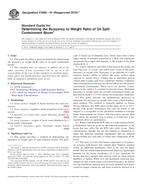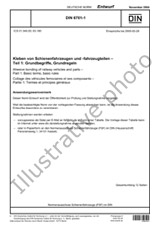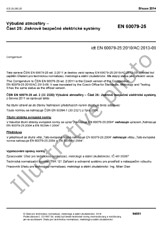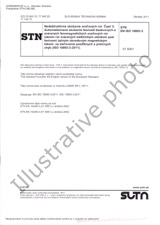We need your consent to use the individual data so that you can see information about your interests, among other things. Click "OK" to give your consent.
ASTM F2682-07(2012)e1
Standard Guide for Determining the Buoyancy to Weight Ratio of Oil Spill Containment Boom (Includes all amendments And changes 5/16/2018).
Automatically translated name:
Standard Guide for Determining the Buoyancy to Weight Ratio of Oil Spill Containment Boom
STANDARD published on 1.6.2012
The information about the standard:
Designation standards: ASTM F2682-07(2012)e1
Note: WITHDRAWN
Publication date standards: 1.6.2012
SKU: NS-54367
The number of pages: 3
Approximate weight : 9 g (0.02 lbs)
Country: American technical standard
Category: Technical standards ASTM
The category - similar standards:
Annotation of standard text ASTM F2682-07(2012)e1 :
Keywords:
boom, buoyancy, oil spill control equipment, oil spill response, spill containment, ICS Number Code 13.060.99 (Other standards related to water quality)
Additional information
| Significance and Use | ||||
|
This guide describes a method of determining the buoyancy to weight ratio of spill response booms. The principle is based on Archimedes Law, which states that a body either wholly or partially immersed in a fluid will experience an upward force equal and opposite to the weight of the fluid displaced by it. Unless otherwise specified, when used in this guide, the term buoyancy to weight ratio (B/W ratio) refers to the gross buoyancy to weight ratio. Buoyancy is an indicator of a spill response boom’s ability to follow the water surface when exposed to current forces, fouling due to microbial growth (which adds weight), and wave conditions. Surface conditions other than quiescent will have an adverse effect on collection or containment performance. When waves are present, conformance to the surface is essential to prevent losses. Minimum buoyancy to weight ratios for oil spill containment booms are specified in Guide F1523 for various environmental conditions. This guide provides the methodology necessary to determine the buoyancy to weight ratio using a fluid displacement method. This method is typically applied to booms having relatively low B/W ratios (in the range of 2:1 to 10:1). Booms with greater buoyancies may also be tested in this manner. It is acceptable to use calculation methods to estimate boom displacement for booms with buoyancies greater than 10:1, where the potential error in doing so would have a less significant effect on performance. When evaluating the B/W ratio of a spill response boom, consideration must be given to the inherent properties of the boom that may affect the net B/W ratio while in use. These considerations include, but are not limited to, absorption of fluids into flotation materials, membranes that are abraded during normal use, and entry of water into components of the boom. The entry of water into boom components is of particular concern with booms that contain their flotation element within an additional membrane. (This is the case for many booms that use rolled-foam flotation and relatively lightweight material for the boom membrane.) It is also important for booms that have pockets that enclose cable or chain tension members or ballast. When new, the membrane enclosure may contain air that would result in increased buoyancy. In normal use, the membrane material may be easily abraded such that it would no longer contain air, and water would be allowed in at abrasion locations. For such booms, the membrane enclosure shall not be considered as part of the flotation of the boom, and the membrane shall be intentionally punctured to allow water to enter during the test procedure. |
||||
| 1. Scope | ||||
|
1.1 This guide describes a practical method for determining the buoyancy to weight (B/W) ratio of oil spill containment booms. 1.2 This standard does not purport to address all of the safety concerns, if any, associated with its use. It is the responsibility of the user of this standard to establish appropriate safety and health practices and determine the applicability of regulatory limitations prior to use. |
||||
| 2. Referenced Documents | ||||
|
Similar standards:
1.5.2013
1.2.2005
1.10.2003
WITHDRAWN
1.10.2014
WITHDRAWN
1.10.2014
1.3.1991
We recommend:
Technical standards updating
Do you want to make sure you use only the valid technical standards?
We can offer you a solution which will provide you a monthly overview concerning the updating of standards which you use.
Would you like to know more? Look at this page.



 DIN EN 60734:2013-05..
DIN EN 60734:2013-05.. E DIN 1999-100:2014-..
E DIN 1999-100:2014-.. STN 757360
STN 757360
 Cookies
Cookies
